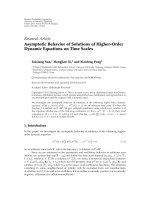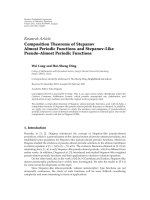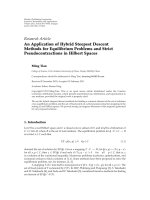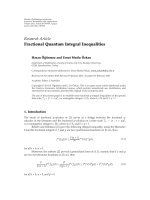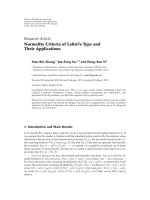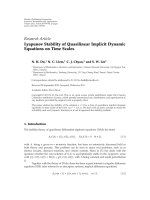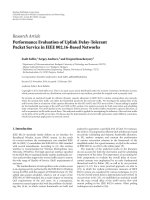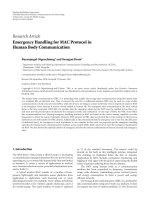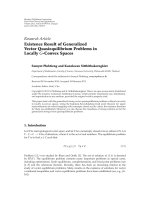Báo cáo hóa học: " Research Article Normality Criteria of Lahiri’s Type and Their Applications" pdf
Bạn đang xem bản rút gọn của tài liệu. Xem và tải ngay bản đầy đủ của tài liệu tại đây (554.88 KB, 16 trang )
Hindawi Publishing Corporation
Journal of Inequalities and Applications
Volume 2011, Article ID 873184, 16 pages
doi:10.1155/2011/873184
Research Article
Normality Criteria of Lahiri’s Type and
Their Applications
Xiao-Bin Zhang,1 Jun-Feng Xu,1, 2 and Hong-Xun Yi1
1
2
Department of Mathematics, Shandong University, Jinan, Shandong 250100, China
Department of Mathematics, Wuyi University, Jiangmen, Guangdong 529020, China
Correspondence should be addressed to Jun-Feng Xu,
Received 22 September 2010; Revised 9 January 2011; Accepted 9 February 2011
Academic Editor: Siegfried Carl
Copyright q 2011 Xiao-Bin Zhang et al. This is an open access article distributed under the
Creative Commons Attribution License, which permits unrestricted use, distribution, and
reproduction in any medium, provided the original work is properly cited.
We prove two normality criteria for families of some functions concerning Lahiri’s type, the results
generalize those given by Charak and Rieppo, Xu and Cao. As applications, we study a problem
related to R. Bruck’s Conjecture and obtain a result that generalizes those given by Yang and
ă
Zhang, Lu, Xu and Chen.
ă
1. Introduction and Main Results
Let denote the complex plane, and let f z be a nonconstant meromorphic function in . It
is assumed that the reader is familiar with the standard notion used in the Nevanlinna value
distribution theory such as the characteristic function T r, f , the proximity function m r, f ,
the counting function N r, f see, e.g., 1–4 , and S r, f denotes any quantity that satisfies
the condition S r, f
o T r, f as r → ∞ outside of a possible exceptional set of finite
linear measure. A meromorphic function a z is called a small function with respect to f z ,
provided that T r, a
S r, f .
Let f z and g z be two nonconstant meromorphic functions. Let a z and b z be
az
g z
b z means f z − a z and g z −
small functions of f z and g z . f z
b z have the same zeros counting multiplicity and f z
∞
g z
∞ means that f and
g have the same poles counting multiplicity . If g z − b z
0 whenever f z − a z
0, we
write f z
a z ⇒g z
b z . If f z
a z ⇒g z
b z and g z
b z ⇒f z
az,
b z . If f z
az ⇔g z
a z , then we say that f and g
we write f z
az ⇔g z
share a.
ª
ª
2
Journal of Inequalities and Applications
Set
M1 f, f , . . . , f
M2 f, f , . . . , f
γM1
∗
γM1
k−1
nj ,
n
n1
ΓM1
j 1
···
n1 ··· nk
fn
P f
k
k
fn f
n1
··· f
k
fm f
m1
··· f
k
nk ,
γM2
jnj ,
∗
γM2
k
,
j 1
m
m1
k−1
mj ,
j 1
nk
,
mk
···
,
1.1
mk ,
ΓM2
k
jmj ,
j 1
where n, n1 , . . . , nk , m, m1 , . . . , mk are nonnegative integers. Mi f, f , . . . , f k is called the
differential monomial of f and γMi is called the degree of Mi f, f , . . . , f k i 1, 2 .
Let F be a family of meromorphic functions defined in a domain D ⊂ . F is said to
be normal in D, in the sense of Montel, if for any sequence fn ∈ F, there exists a subsequence
fnj such that fnj converges spherically locally uniformly in D, to a meromorphic function or
∞.
According to Bloch’s principle, every condition which reduces a meromorphic
function in to a constant makes a family of meromorphic functions in a domain D normal.
Although the principle is false in general, many authors proved normality criteria for families
of meromorphic functions starting from Picard type theorems, for instance.
Theorem A see 5 . Let n ≥ 5 be an integer, a, b ∈
f af n / b for all z ∈ , then f must be a constant.
and a / 0. If, for a meromorphic function f,
Theorem B see 6, 7 . Let n ≥ 3 be an integer, a, b ∈ , a / 0, and let F, be a family of meromorphic
functions in a domain D. If f af n / b for all f ∈ F, then F is a normal family.
In 2005, Lahiri 8 got a normality criterion as follows.
Theorem C. Let F be a family of meromorphic functions in a complex domain D. Let a, b ∈
that a / 0. Define
Ef
z∈D:f z
a
f z
b .
such
1.2
If there exists a positive constant M such that |f z | ≥ M for all f ∈ F whenever z ∈ Ef , then F is a
normal family.
In 2009, Charak and Rieppo 9 generalized Theorem C and obtained two normality
criteria of Lahiri’s type.
Journal of Inequalities and Applications
3
Theorem D. Let F be a family of meromorphic functions in a complex domain D. Let a, b ∈ such
m2 ≥ 1,
that a / 0. Let m1 , m2 , n1 , n2 be positive integers such that m1 n2 − m2 n1 > 0, m1
n2 ≥ 2, and put
n1
Ef
n1
z∈D: f z
f z
m1
f z
n2
a
f z
b
m2
.
1.3
If there exists a positive constant M such that |f z | ≥ M for all f ∈ F whenever z ∈ Ef , then F is a
normal family.
Theorem E. Let F be a family of meromorphic functions in a complex domain D. Let a, b ∈
that a / 0. Let m1 , m2 , n1 , n2 be nonnegative integers such that m1 n2 m2 n1 , and put
Ef
z∈D: f z
n1
f z
a
m1
f z
n2
f z
b .
m2
such
1.4
If there exists a positive constant M such that |f z | ≥ M for all f ∈ F whenever z ∈ Ef , then F is a
normal family.
with f
Very recently, Xu and Cao 10 further extended Theorems D and E by replacing f
k
; they got
Theorem F. Let F be a family of meromorphic functions in a complex domain D, all of whose zeros
have multiplicity at least k. Let a, b ∈ such that a / 0. Let m1 , m2 , n1 , n2 be nonnegative integers
such that m1 n2 − m2 n1 > 0, m1 m2 ≥ 1, n1 n2 ≥ 2, (if n1 n2 1, k ≥ 5), and put
Ef
z∈D: f z
n1
f
k
z
a
m1
f z
n2
f
k
z
m2
b .
1.5
If there exists a positive constant M such that |f z | ≥ M for all f ∈ F whenever z ∈ Ef , then F is a
normal family.
Theorem G. Let F be a family of meromorphic functions in a complex domain D, all of whose zeros
have multiplicity at least k. Let a, b ∈ such that a / 0. Let m1 ≥ 2, m2 , n1 , n2 be positive integers
such that m1 n2 m2 n1 , and put
Ef
z∈D: f z
n1
f
k
z
a
m1
f z
n2
f
k
z
m2
b .
1.6
If there exists a positive constant M such that |f z | ≥ M for all f ∈ F whenever z ∈ Ef , then F is a
normal family.
To prove Theorems D–G, the authors used a key lemma Lemma 2.4 in this paper
besides Zalcman-Pang’s Lemma. It’s natural to ask whether such normality criteria of Lahiri’s
4
Journal of Inequalities and Applications
type still hold for the general differential monomial M f, f , . . . , f
and obtain the following theorem.
k
. We study this problem
Theorem 1.1. Let F be a family of meromorphic functions in a complex domain D, for every f ∈ F,
such that a / 0, let m, n, k ≥ 1 , mj ,
all zeros of f have multiplicity at least k. Let a, b ∈
nj j 1, 2, . . . , k be nonnegative integers such that
γM2 ΓM1 − γM1 ΓM2 > 0,
nk
mk > 0,
m
n ≥ 2.
1.7
Put
Ef
z ∈ D : M1 f, f , . . . , f
k
a
M2 f, f , . . . , f
k
b .
1.8
If there exists a positive constant M such that |f z | ≥ M for all f ∈ F whenever z ∈ Ef , then F is a
normal family.
Theorem 1.2. Let F be a family of meromorphic functions in a complex domain D, for every f ∈ F,
such that a / 0, let m, n, k ≥ 1 , mj ,
all zeros of f have multiplicity at least k. Let a, b ∈
∗
∗
nj j
1, 2, . . . , k be nonnegative integers such that mnmk nk γM1 γM2 > 0, (k / 2 when n 1 or
m 1), m/n mj /nj for all positive integers mj and nj , 1 ≤ j ≤ k . Put
Ef
z ∈ D : M1 f, f , . . . , f
k
a
M2 f, f , . . . , f
k
b .
1.9
If there exists a positive constant M such that |f z | ≥ M for all f ∈ F whenever z ∈ Ef , then F is a
normal family.
As an application of Theorem 1.1, we obtain the following theorem.
Theorem 1.3. Let F be a family of holomorphic functions in a domain D, for every f ∈ F, all zeros of
f have multiplicity at least k. Let a, b / 0 be two finite values and n, k, n1 , . . . , nk be nonnegative
integers with n ≥ 1, k ≥ 1, nk ≥ 1. For every f ∈ F, all zeros of f have multiplicity at least k, if
b, then F is normal in D.
P f
a ⇔ M1 f, f , . . . , f k
Example 1.4. Let D {z : |z| < 1} and F {fm }. If a 0, let fm : emz . For each function
f ∈ F, P f and M1 f, f , . . . , f k share 0 in D. However, it can be easily verified that F is
not normal in D. Example 1.4 shows that the condition b / 0 in Theorem 1.3 is sharp.
Example 1.5. Let D
{z : |z| < 1} and F
{fm }. If a / 0, let fm : m eλz − e−λz , where
2
b/a. For each function f ∈ F, f
b/a f, f n 1
a ⇔ f nf
b in
λ is the root of z
D. However, it can be easily verified that F is not normal in D. Example 1.5 shows that the
multiplicity restriction on zeros of f in Theorem 1.3 is sharp at least for k 2 .
Journal of Inequalities and Applications
5
2. Preliminary Lemmas
Lemma 2.1 see 11 . Let F be a family of meromorphic functions on the unit disc Δ, all of whose
zeros have the multiplicity at least k, then if F is not normal, there exist, for each 0 ≤ α < k
a a number r, 0 < r < 1,
b points zn , |zn | < r,
c functions fn ∈ F, and
d positive numbers ρn → 0
−α
such that ρn fn zn ρn ξ
gn ξ → g ξ locally uniformly with respect to the spherical metric,
where g ξ is a nonconstant meromorphic function on , all of whose zeros have multiplicity at least
k, such that g # ξ ≤ g # 0 . Here, as usual, g # z
|g z |/ 1 |g z |2 is the spherical derivative.
Lemma 2.2 see 1, page 158 . Let F
{f} be a family of meromorphic functions in a domain
D ⊂ . Then F is normal in D if and only if the spherical derivatives of functions f ∈ F are uniformly
bounded on each compact subset of D.
Lemma 2.3 see 12 . Let f be an entire function and M a positive integer. If f # z ≤ M for all
z ∈ , then f has the order at most one.
Lemma 2.4 see 13 . Take nonnegative integers n, n1 , . . . , nk with n ≥ 1, n1 n2 · · · nk ≥ 1
and define d n n1 n2 · · · nk . Let f be a transcendental meromorphic function with the deficiency
δ 0, f > 3/ 3d 1 . Then for any nonzero value c, the function f n f n1 · · · f k nk −c has infinitely
many zeros. Moreover, if n ≥ 2, the deficient condition can be omitted.
The following two lemmas can be seen as supplements of Lemma 2.4.
Lemma 2.5. Take nonnegative integers n, n1 , . . . , nk with n ≥ 1, nk ≥ 1 and define d n n1
n2 · · · nk . Let f be a transcendental meromorphic function whose zeros have multiplicity at least k.
Then for any nonzero value c, the function f n f n1 · · · f k nk − c has infinitely many zeros, provided
that n1
n2
···
nk−1 ≥ 1 and k / 2 when n 1. Specially, if f is transcendental entire, the
function f n f n1 · · · f k nk − c has infinitely many zeros.
Proof. If n1 n2 · · · nk−1
0, then f n f n1 · · · f k nk
f n f k nk , this case has been
considered see 5, 12–20 .
n2
···
nk−1 ≥ 1 and if n ≥ 2, we immediately get the conclusion from
If n1
Lemma 2.4. Next we consider the case n 1.
Let Ψ f n f n1 · · · f k nk . Using the proof of Lemma 2.4 see 13, page 161–163 ,
we obtain
3d − 2 T r, f ≤ 3dN r,
1
f
Ψ−c
N r,
Ψ
N r,
1
f
4N r,
Ψ−c
− 3N r,
Ψ
1
Ψ−c
S r, f .
2.1
6
Journal of Inequalities and Applications
Suppose that z0 is a zero of f of multiplicity p ≥ k , then z0 is a zero of Ψ of multiplicity
dp − Σk 1 jnj , and thus is a pole of Ψ − c /Ψ of multiplicity dp − Σk 1 jnj − 1. Thereby, from
j
j
2.1 we get
⎛
3d − 2 T r, f ≤ ⎝3
⎞
k
5⎠N r,
jnj
j 1
≤
Note that n
k
j 1
3
4N r,
1
Ψ−c
S r, f
2.2
jnj
5
k
N r,
1
f
4N r,
1
Ψ−c
S r, f .
1, we deduce from 2.2 that
k−5
k−1
j 1
3
k − j nj
k
If k
1
f
T r, f ≤ 4N r,
1
Ψ−c
S r, f .
2.3
1, then Ψ f n f n1 ; this case has been proved as mentioned above see 13–16 .
If k ≥ 5, then we have k − 5 3 k−1 k − j nj > 0; the conclusion is evident.
j 1
· · · nk−1 ≥ 1 and we deduce that k − 5 3 k−1 k −
If 3 ≤ k ≤ 4, note that n1 n2
j 1
j nj > 0, thus the conclusion holds.
If f is a transcendental entire function, we only need to consider the case k ≥ 2. Note
that see Hu et al. 21, page 67
dT r, f ≤ dN r,
1
f
N r,
1
Ψ−c
− N r,
Ψ−c
Ψ
S r, f .
2.4
With similar discussion as above, we obtain
⎛
⎝n
k−1
j 1
k − j nj − 1
k
⎞
⎠T r, f ≤ N r,
1
Ψ−c
S r, f .
2.5
k−1
In view of n ≥ 1 and k ≥ 2, we get n
j 1 k − j nj − 1 /k > 0, thus we immediately obtain
the conclusion. This completes the proof of Lemma 2.5.
Lemma 2.6. Take nonnegative integers n, n1 , . . . , nk , k with n ≥ 1, nk ≥ 1, k ≥ 1 and define
d n n1
n2
· · · nk . Let f be a nonconstant rational function whose zeros have multiplicity
at least k. Then for any nonzero value c, the function f n f n1 · · · f k nk − c has at least one finite
zero.
Proof. Since the case k
consider k ≥ 2.
1 has been proved by Charak and Rieppo 9 , we only need to
Journal of Inequalities and Applications
n1
Suppose that f n f
··· f
nk
k
7
− c has no zero.
Case 1. If f is a nonconstant polynomial, since the zeros of f have multiplicity at least k, we
know that f n f n1 · · · f k nk is also a nonconstant polynomial, so f n f n1 · · · f k nk − c has
at least one zero, which contradicts our assumption.
Case 2. If f is a nonconstant rational function but not a polynomial. Set
f z
z − a1
A
m1
z − b1
z − a2
l1
m2
l2
z − b2
· · · z − as
· · · z − bt
ms
,
lt
2.6
where A is a nonzero constant and mi ≥ k i 1, 2, . . . , s , lj ≥ 1 j
Then by mathematical induction, we get
f
k
z
z − a1
A
m1 −k
z − b1
m2 −k
z − a2
l1 k
· · · z − as
l2 k
z − b2
where gk z
M − N M − N − 1 · · · M − N − k 1 zk
are constants and
ms −k
· · · z − bt
s t−1
1, 2, . . . , t .
gk z
lt k
cm zk
2.7
,
s t−1 −1
· · · c0 , cm , . . . , c0
m2
···
ms
l2
···
lt
N ≥ t.
2.9
deg gk ≤ k s
t−1 .
2.10
m1
l1
M ≥ ks,
2.8
It is easily obtained that
Combining 2.6 and 2.7 yields
fn f
where g z
n1
··· f
nj
k
j 1 gj
k
nk
Ad
z − a1
dm1 −
z − b1
z with deg g ≤
k
j 1
dl1
jnj s
k
j 1
jnj
k
j 1
· · · z − as
jnj
dms −
· · · z − bt
dlt
k
j 1
jnj
k
j 1
g z
jnj
2.11
t−1 .
Moreover, g z is not a constant, or else, we get gj is a constant for j
leading coefficient of gj is M − N − j − 1 s t .
If g1 is a constant, then we get
M
,
N.
1, . . . , k. The
2.12
If gk is a constant, then we get
k−1 s
which implies k
t
0,
1, a contradiction with the assumption k ≥ 2.
2.13
8
Journal of Inequalities and Applications
Then from 2.11 , we obtain
f
n
f
n1
··· f
nk
k
A
d
z − a1
k
j 1
dm1 −
k
j 1
dl1
z − b1
jnj −1
· · · z − as
jnj 1
dms −
· · · z − bt
k
j 1
dlt
k
where h z is a polynomial with s t − 1 ≤ deg h ≤
1 s
j 1 jnj
n1
nk
Since f n f
··· f k
− c / 0, we obtain from 2.11 that
fn f
n1
··· f
nk
k
c
jnj −1
k
j 1
h z
jnj 1
z − b1
jnj
· · · z − bt
2.14
t−1 .
B
k
j 1
dl1
,
,
dlt
k
j 1
jnj
dlt
k
j 1
jnj 1
2.15
where B is a nonzero constant. Then
fn f
n1
··· f
B·H z
nk
k
z − b1
dl1
k
j 1
jnj 1
· · · z − bt
,
2.16
where H z is a polynomial with deg H
t − 1.
From 2.14 and 2.16 , we deduce that
⎛
dM − ⎝
⎞
k
jnj
1⎠s
deg h
deg H
t − 1,
2.17
j 1
in view of deg h ≥ s
t
1, together with 2.8 , we have
dks ≤
k
jnj s,
2.18
k − j nj s ≤ 0.
2.19
j 1
namely
k
nks
j 1
which is a contradiction since n ≥ 1.
Hence f n f n1 · · · f k nk − c has at least one finite zero.
This proves Lemma 2.6.
Remark 2.7. Lemma 2.6 is a generalization of Lemma 2.2 in 10 . The proof of Lemma 2.6 is
quite different from its proof. Actually, the proof of Lemma 2.2 in 10 is incorrect. The main
problem appears at 2.2 in 10 . Since f has only zero with multiplicity at least k, then each
zero of f n is of multiplicity at least nk, but this does not mean that each zero of f n f k m is
of multiplicity at least nk because the zeros of f k may not be the zeros of f, and thus their
multiplicity may less than nk. Therefore, the inequality of 2.2 in 10 is not valid, which
implies that the proof of Lemma 2.2 in 10 is not correct.
Journal of Inequalities and Applications
9
Lemma 2.8. Let a, b ∈ such that a / 0. Let m, n, k ≥ 1 , mj , nj j 1, 2, . . . , k be nonnegative
∗
∗
integers such that mnmk nk γM1 γM2 > 0, (k / 2 when n 1 or m 1), m/n mj /nj for all positive
integers mj and nj , 1 ≤ j ≤ k . Let f be a meromorphic function in ; all zeros of f have multiplicity
at least k. Define
Φ z
M1 f, f , . . . , f
a
M2 f, f , . . . , f
k
k
− b.
2.20
Then Φ z has a finite zero.
Proof. The algebraic complex equation
a
x
xm/n
b
2.21
has always a nonzero solution, say x0 ∈ . By Lemmas 2.5 and 2.6, the differential
such that
monomial M1 f, f , . . . , f k cannot avoid it and thus there exists z0 ∈
x0 .
M1 f z0 , f z0 , . . . , f k z0
Under the assumptions, for all positive integers m, n, mj , nj , we have
m
n
m
,
n
nj
mj
m
.
n
2.22
Thus
Φ z0
M1 f z0 , f z0 , . . . , f
k
a
z0
m/n
M1
f z0 , f z0 , . . . , f
k
z0
−b
0.
2.23
This proves Lemma 2.8.
Lemma 2.9 see 2, page 51 . If f is an entire function of order σ f , then
σ f
lim sup
r →∞
log ν r, f
,
log r
2.24
where ν r, f denotes the central-index of f z .
Lemma 2.10 see 22, page 187–199 or 2, page 51 . If g is a transcendental entire function, let
0 < δ < 1/4 and z be such that |z| r and that |g z | M r, g ν r, g − 1/4 δ holds. Then there
exists a set F ⊂ Ê of finite logarithmic measure, that is, F dt/t < ∞ such that
g
m
g z
holds for all m ≥ 0 and all r ∈ F.
/
z
ν r, g
z
m
1
o1
2.25
10
Journal of Inequalities and Applications
3. Proof of Theorem 1.1
Without loss of generality, we may assume D
Δ
{z : |z| < 1}. Suppose that F is not
normal at z0 ∈ D. By Lemma 2.1, for 0 ≤ α < k, there exist r < 1, zj ∈ Δ such that zj → z0 ,
−α
fj ∈ F and ρj → 0 such that gj ξ
ρj fj zj ρj ξ → g ξ locally uniformly with respect
to the spherical metric, where g ξ is a nonconstant meromorphic function on , all of whose
zeros have multiplicity at least k. For simplicity, we denote fj zj ρj ξ by fj . By Lemmas 2.4
and 2.6, there exists ξ0 ∈ such that
g ξ0
n
n1
g ξ0
··· g
k
a
nk
ξ0
m
g ξ0
m1
g ξ0
··· g
k
0.
mk
ξ0
3.1
Obviously, g ξ0 / 0, ∞, so in some neighborhood of ξ0 , gj ξ converges uniformly to g ξ .
We have
gj ξ
n
gj ξ
n1
−αγM1 ΓM1
ρj
· · · gj
fjn fj
k
a
nk
ξ
m
gj ξ
n1
· · · fj
k
m1
gj ξ
αγM2 −ΓM2
· · · gj
k
− ρj
mk
ξ
a
nk
−αγM ΓM
ρj 2 2 fjm
αγM2 −ΓM2
m1
fj
b
· · · fj
mk
k
− ρj
b
⎤
⎡
αγM2 −ΓM2 ⎢ −α γM1 γM2
⎣ρj
ΓM1 ΓM2
ρj
n1
fjn fj
· · · fj
k
⎥
− b ⎦.
a
nk
fjm
fj
m1
· · · fj
k
mk
3.2
Let α
obtain
ΓM1
ΓM2 / γM1
γM2 < k, and under the assumption γM2 ΓM1 − γM1 ΓM2 > 0, we
n1
gn g
··· g
k
a
nk
gm
g
m1
··· g
k
3.3
mk
is the uniform limit of
⎤
⎡
ρj
γM2 ΓM1 −γM1 ΓM2 / γM1 γM2
⎢ n
⎣fj fj
n1
· · · fj
k
a
nk
fjm
m1
fj
· · · fj
mk
k
⎥
− b⎦
3.4
in some neighborhood of ξ0 .
By 3.1 and Hurwitz’s theorem, there exists a sequence ξj → ξ0 such that for all large
values of j and ζj zj ρj ξj ,
fj ζj
n
fj ζj
n1
· · · fj
k
ζj
a
nk
fj ζj
m
fj ζj
m1
· · · fj
k
ζj
mk
b.
3.5
Journal of Inequalities and Applications
Hence for all large values of j, ζj
11
ρj ξj ∈ Ef , it follows from the condition that
zj
gj ξj
fj ζj
α
ρj
≥
M
α.
ρj
3.6
Since ξ0 is not a pole of g, there exists a positive number K such that in some neighborhood
of ξ0 we get |g ξ | ≤ K.
Since gj ξ converges uniformly to g ξ in some neighborhood of ξ0 , we get for all large
values of j and for all ξ in that neighborhood of ξ0
gj ξ − g ξ
< 1.
3.7
By 3.7 , we get
K ≥ g ξj
≥ gj ξj
− gj ξj − g ξj
≥
M
,
−1
3.8
α
ρj
which is a contradiction since ρj → 0 as j → ∞.
This completes the proof of Theorem 1.1.
4. Proof of Theorem 1.2
Without loss of generality, we may assume D
Δ
{z : |z| < 1}. Suppose that F is not
normal in D. By Lemma 2.1, for 0 ≤ α < k, there exist r < 1, zj ∈ Δ, fj ∈ F and ρj → 0 such
−α
ρj fj zj ρj ξ → g ξ locally uniformly with respect to the spherical metric,
that gj ξ
where g ξ is a nonconstant meromorphic function on , all of whose zeros have multiplicity
at least k. By Lemma 2.8, we get
g ξ0
n
g ξ0
n1
··· g
k
ξ0
a
nk
g ξ0
m
g ξ0
m1
··· g
k
ξ0
mk
−b
0,
4.1
for some ξ0 ∈ .
We can arrive at a contradiction by using the same argument as in the latter part of
proof of Theorem 1.1.
This completes the proof of Theorem 1.2.
5. Applications
Proof of Theorem 1.3. We shall divide our argument into two cases.
Case 1 a / 0 . Let M be a positive constant with M ≤
have
Ef
z ∈ D : M1 f, f , . . . , f
γM
1
k
|a|; under the assumptions, we
b
5.1
12
Journal of Inequalities and Applications
and |f z | ≥ M for all f ∈ F whenever z ∈ Ef ; by Lemmas 2.5 and 2.6, using the similar proof
of Theorem 1.1, we obtain the conclusion.
Case 2 a 0 . For f ∈ F, if f z0
0 for z0 ∈ D, since P f
0 ⇒ M1 f, f , . . . , f k
b, we
have b 0, which is a contradiction, hence f / 0.
If M1 f z0 , f z0 , . . . , f k z0
b for z0 ∈ D, since M1 f, f , . . . , f k
b⇒P f
0 and hence M1 f, f , . . . , f k
b
0, which is still a
0, we immediately get f z0
contradiction, hence M1 f, f , . . . , f k / b.
Suppose that F is not normal in D, by Lemma 2.1, there exist r < 1, zj ∈ Δ, fj ∈ F,
−ΓM /γM
ρj 1 1 fj zj ρj ξ → g ξ locally uniformly with respect
and ρj → 0 such that gj ξ
to the spherical metric, where g ξ is a nonconstant entire function, all of whose zeros have
multiplicity at least k. By Hurwitz’s theorem, we have
i g ≡ 0 or g / 0, and
ii g n g
n1
··· g
k
nk
≡ b or g n g
n1
··· g
nk
k
/ b.
Since g is not a constant, we have g / 0. By Lemma 2.3, g has the order at most 1, so g ξ
ecξ d , where c / 0 , d are two constants. Thus
gn ξ g
If g n g
n1
··· g
k
nk
n1
ξ ··· g
nk
k
cΓM1 eγM1
ξ
cξ d
.
5.2
≡ b, we immediately get a contradiction. Hence
gn g
n1
··· g
k
nk
/ b,
5.3
but by Lemmas 2.5 and 2.6 we get a contradiction again.
This proves Theorem 5.1.
Further more, using Theorem 1.3, we obtain a uniqueness theorem related to R. Brucks
ă
Conjecture. Firstly, we recall this conjecture.
R. Brucks Conjecture
ă
Let f be a nonconstant entire function such that the hyper-order σ2 f is not a positive integer and
σ2 f < ∞. If f and f share a finite value a CM, then
f −a
f −a
c,
5.4
where c is a nonzero constant and the hyper-order σ2 f is defined as follow:
σ2 f
lim sup
r →∞
log log T r, f
.
log r
5.5
Journal of Inequalities and Applications
13
Since then, many results related to this conjecture have been obtained. We refer the
reader to Bruck 23 , Gundersen and Yang 24 , Yang 25 , Chen and Shon 26 , Li and Gao
ă
27 , and Wang 28 .
It’s interesting to ask what happens if f is replaced by f n in Brucks Conjecture.
ă
Recently, Yang and Zhang 29 considered this problem and got the following theorem.
Theorem H. Let f be a nonconstant entire function. n ≥ 7 be an integer, and let F
share 1 CM, then F F , and f assumes the form
cez/n ,
f z
f n . If F and F
5.6
where c is a nonzero constant.
Lu et al. 30 improves Theorem H and obtained the following theorem.
ă
Theorem I. Let Q1 / 0 be a polynomial, and let n ≥ 2 be an intege; let f z be a transcendental
≡
entire function, and let F z
f z n . If F z and F z share Q1 CM, then
Aez/n ,
f z
5.7
where A is a nonzero constant.
We obtain a more general result as follows.
Theorem 5.1. Let n, k, n1 , . . . , nk be nonnegative integers with n ≥ 1, k ≥ 1, nk ≥ 1, and a, b be two
finite nonzero values. Let f be a nonconstant entire function whose zeros have multiplicity at least k.
f n f n1 · · · f k nk b, then
If f n n1 ··· nk a
ª
nk
n
fn f 1 · · · f k
−b
n n1 ··· nk − a
f
where c is a nonzero constant. Specially, if a
is the root of tΓM1 1.
b, then f
5.8
c,
c1 eωz , where c1 is a nonzero constant, ω
Proof of Theorem 5.1. First we assert that σ f ≤ 1. Let
F
gω z
f z
ω ,ω ∈
z∈D
,
Δ.
5.9
Under the assumptions of Theorem 1.3, we get that F is a normal family of holomorphic
functions in D. By Lemma 2.2, there exists a constant M such that
f# ω
gω 0
f ω
1
f ω
2
1
gω 0
2
#
gω 0 ≤ M,
for all ω ∈ . Hence by Lemma 2.3, f has the order at most 1.
5.10
14
Journal of Inequalities and Applications
Since f n
function and
n1 ··· nk
a
ªf
n
n1
f
··· f
nk
k
b, f must be a transcendental entire
n
n
fn f 1 · · · f k k − b
f n n1 ··· nk − a
eα z .
5.11
From 5.11 , we have T r, eα z
O T r, f , hence σ eα ≤ σ f ≤ 1 and α z is a polynomial
with deg α ≤ 1. Note that f is transcendental, we have M r, f → ∞, as r → ∞. Let
f zn , where zn rn eiθn , we deduce
M rn , f
lim
rn → ∞ f
1
zn
lim
rn → ∞ M
1
rn , f
0.
5.12
By Lemma 2.10, there exists a subset F1 ⊂ 1, ∞ of finite logarithmic measure, namely
dt/t < ∞ such that for some point zn
rn eiθn θn ∈ 0, 2π satisfying |zn | rn ∈ F1
/
F1
and M rn , f
|f zn |, we obtain
f
k
k
ν rn , f
zn
zn
f zn
1
5.13
o1 ,
as r → ∞.
Rewrite 5.11 as
f /f
n1
· · · f k /f
1 − a/f n
nk
− b/f n
n1 ··· nk
n1 ··· nk
eα z ,
5.14
it follows from 5.12 – 5.14 and Lemma 2.8 that
|α zn |
log eα zn
ΓM1 log ν rn , f − log rn eiθn
ΓM1 log ν rn , f − log rn − iθ rn
o1
o1
5.15
≤ O log rn ,
as rn → ∞. Since α z is a polynomial, from 5.15 , we deduce that α z is a constant. Let
eα c, then c is a nonzero constant. Thus
n
n
fn f 1 · · · f k k − b
f n n1 ··· nk − a
Specially, if a
b, suppose that f has a zero z0 , by letting z
f n1
··· nk
f
n1
··· f
k
5.16
c.
nk
z0 in 5.16 , we get c
.
1; hence
5.17
Journal of Inequalities and Applications
15
Suppose that z0 is a zero of f with multiplicity p ≥ k , then z0 is a zero of f n1 ··· nk with
multiplicity n1 · · · nk p, and a zero of f n1 · · · f k nk with multiplicity n1 · · · nk p−ΓM1 ,
which is a contradiction. So f has no zero, note that f is a transcendental entire function and
σ f ≤ 1, we have f c1 etz , where c1 and t are two finite nonzero values. In view of 5.16
and a b, we deduce that
ΓM1
c1
tΓM1 − c eγM1 tz
b 1−c ;
hence c 1 and tΓM1 c 1. f c1 eωz , ω is the root of tΓM1
This completes the proof of Theorem 5.1.
5.18
1.
Acknowledgments
The authors thank the referees for reading the manuscript very carefully and making a
number of valuable suggestions to improve the readability of the paper. The authors were
supported by NSF of China no. 10771121 , NSF of Shandong Province no. Z2008A01 and
NSF of Guangdong Province no. 9452902001003278 .
References
1 W. K. Hayman, Meromorphic Functions, Oxford Mathematical Monographs, Oxford University Press,
London, UK, 1964.
2 I. Laine, Nevanlinna Theory and Complex Differential Equations, vol. 15 of de Gruyter Studies in
Mathematics, Walter de Gruyter, Berlin, Germany, 1993.
3 C.-C. Yang and H.-X. Yi, Uniqueness Theory of Meromorphic Functions, vol. 557 of Mathematics and Its
Applications, Kluwer Academic Publishers Group, Dordrecht, The Netherlands, 2003.
4 L. Yang, Value Distribution Theory, Springer, Berlin, Germany, 1993.
5 W. K. Hayman, “Picard values of meromorphic functions and their derivatives,” Annals of
Mathematics, vol. 70, pp. 9–42, 1959.
6 X. C. Pang, “Bloch’s principle and normal criterion,” Science in China, vol. 32, no. 7, pp. 782–791, 1989.
7 X. C. Pang, “On normal criterion of meromorphic functions,” Science in China, vol. 33, no. 5, pp. 521–
527, 1990.
8 I. Lahiri, “A simple normality criterion leading to a counterexample to the converse of the Bloch
principle,” New Zealand Journal of Mathematics, vol. 34, no. 1, pp. 61–65, 2005.
9 K. S. Charak and J. Rieppo, “Two normality criteria and the converse of the Bloch principle,” Journal
of Mathematical Analysis and Applications, vol. 353, no. 1, pp. 43–48, 2009.
10 J. Xu and W. Cao, “Some normality criteria of meromorphic functions,” Journal of Inequalities and
Applications, vol. 2010, Article ID 926302, 10 pages, 2010.
11 X. Pang and L. Zalcman, “Normal families and shared values,” The Bulletin of the London Mathematical
Society, vol. 32, no. 3, pp. 325–331, 2000.
12 J. Clunie and W. K. Hayman, “The spherical derivative of integral and meromorphic functions,”
Commentarii Mathematici Helvetici, vol. 40, pp. 117–148, 1966.
13 C. C. Yang and P. C. Hu, “On the value distribution of f f k ,” Kodai Mathematical Journal, vol. 19, no.
2, pp. 157–167, 1996.
n
14 A. Alotaibi, “On the zeros of af f k − 1 for n ≥ 2,” Computational Methods and Function Theory, vol.
4, no. 1, pp. 227–235, 2004.
15 W. Bergweiler and A. Eremenko, “On the singularities of the inverse to a meromorphic function of
finite order,” Revista Matem´ tica Iberoamericana, vol. 11, no. 2, pp. 355–373, 1995.
a
16 H. H. Chen and M. L. Fang, “The value distribution of f n f ,” Science in China, vol. 38, no. 7, pp.
789–798, 1995.
17 W. K. Hayman, Research Problems in Function Theory, The Athlone Press, London, UK, 1967.
ă
18 E. Mues, Uber ein problem von Hayman,” Mathematische Zeitschrift, vol. 164, no. 3, pp. 239–259, 1979.
16
Journal of Inequalities and Applications
19 X. Pang and L. Zalcman, “On theorems of Hayman and Clunie,” New Zealand Journal of Mathematics,
vol. 28, no. 1, pp. 71–75, 1999.
20 J. P. Wang, “A fundamental inequality of the theory of meromorphic functions and its applications,”
Acta Mathematica Sinica. Chinese Series, vol. 49, no. 2, pp. 443–450, 2006.
21 P.-C. Hu, P. Li, and C.-C. Yang, Unicity of Meromorphic Mappings, vol. 1 of Advances in Complex Analysis
and Its Applications, Kluwer Academic Publishers, Dordrecht, The Netherlands, 2003.
22 G. Jank and L. Volkmann, Einfuhrung in die Theorie der Ganzen und Meromorphen Funktionen mit
ă
Anwendungen auf Dierentialgleichungen, Birkhă user, Basel, Switzerland, 1985.
a
23 R. Bruck, “On entire functions which share one value CM with their rst derivative, Results in
ă
Mathematics, vol. 30, no. 1-2, pp. 21–24, 1996.
24 G. G. Gundersen and L.-Z. Yang, “Entire functions that share one value with one or two of their
derivatives,” Journal of Mathematical Analysis and Applications, vol. 223, no. 1, pp. 88–95, 1998.
25 L.-Z. Yang, “Solution of a differential equation and its applications,” Kodai Mathematical Journal, vol.
22, no. 3, pp. 458–464, 1999.
26 Z.-X. Chen and K. H. Shon, “On conjecture of R. Bruck concerning the entire function sharing one
ă
value CM with its derivative, Taiwanese Journal of Mathematics, vol. 8, no. 2, pp. 235–244, 2004.
27 X.-M. Li and C.-C. Gao, “Entire functions sharing one polynomial with their derivatives,” Proceedings
of the Indian Academy of Sciences, vol. 118, no. 1, pp. 13–26, 2008.
28 J. Wang, “Uniqueness of entire function sharing a small function with its derivative,” Journal of
Mathematical Analysis and Applications, vol. 362, no. 2, pp. 387–392, 2010.
29 L.-Z. Yang and J.-L. Zhang, “Non-existence of meromorphic solutions of a Fermat type functional
equation,” Aequationes Mathematicae, vol. 76, no. 1-2, pp. 140–150, 2008.
30 F. Lu, J. Xu, and A. Chen, “Entire functions sharing polynomials with their rst derivatives, Archiv
ă
der Mathematik, vol. 92, no. 6, pp. 593–601, 2009.
